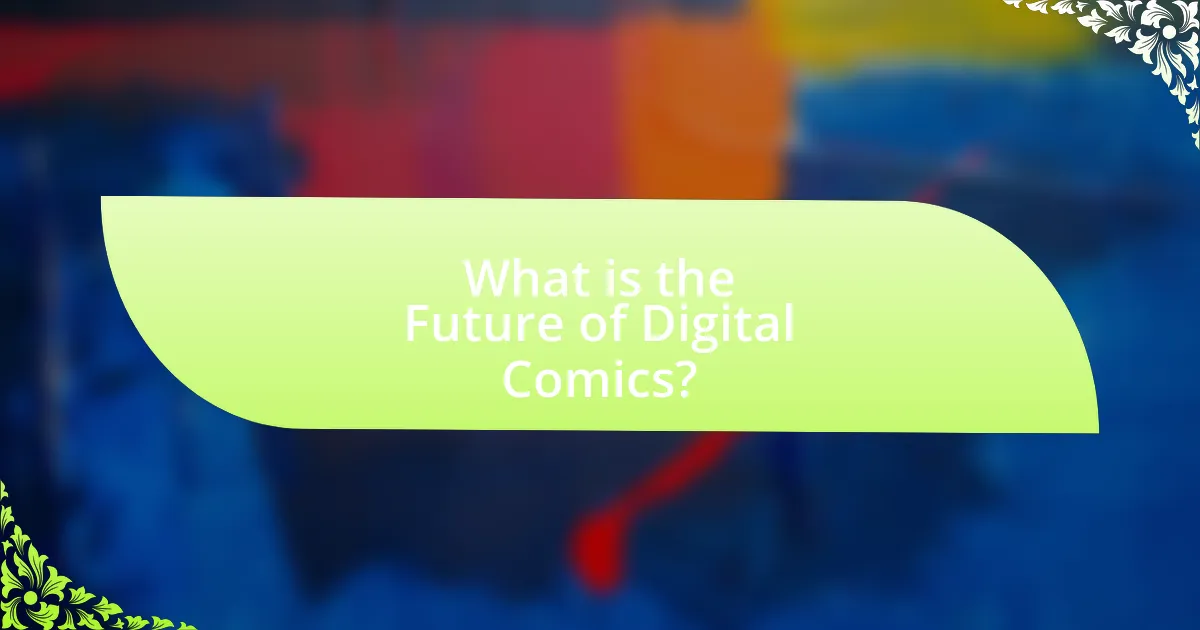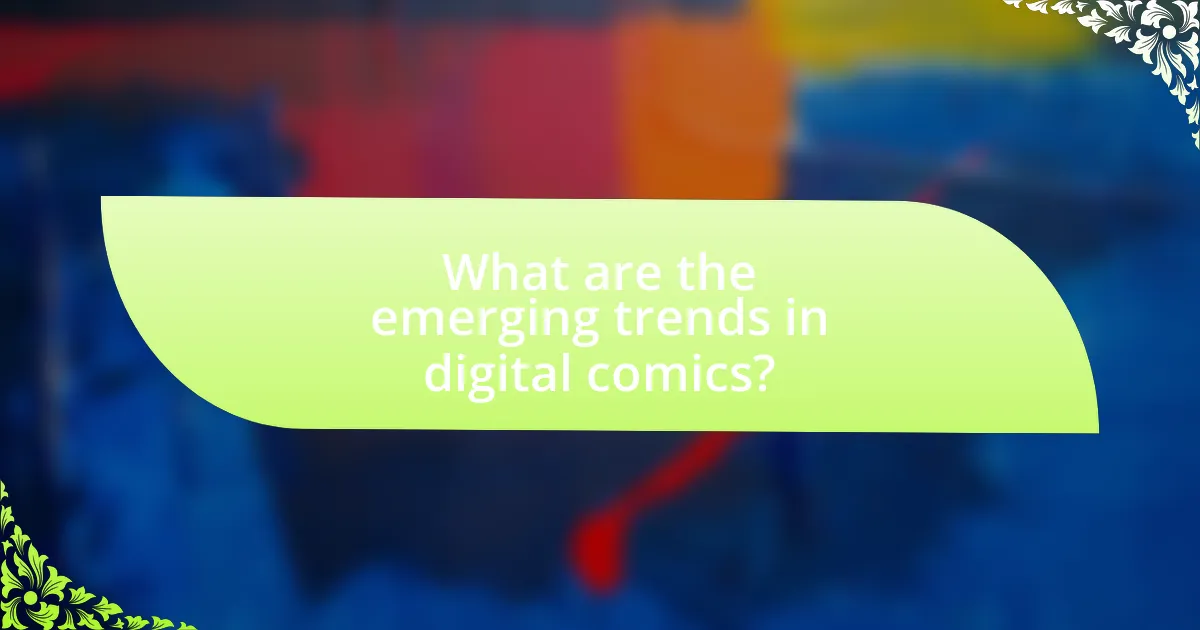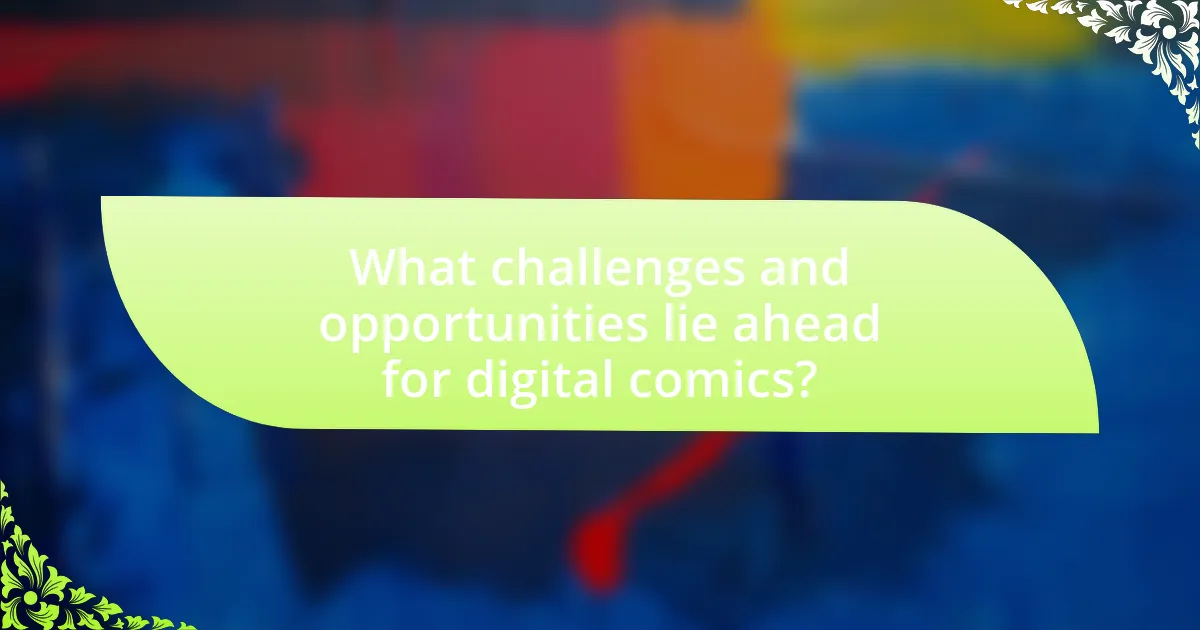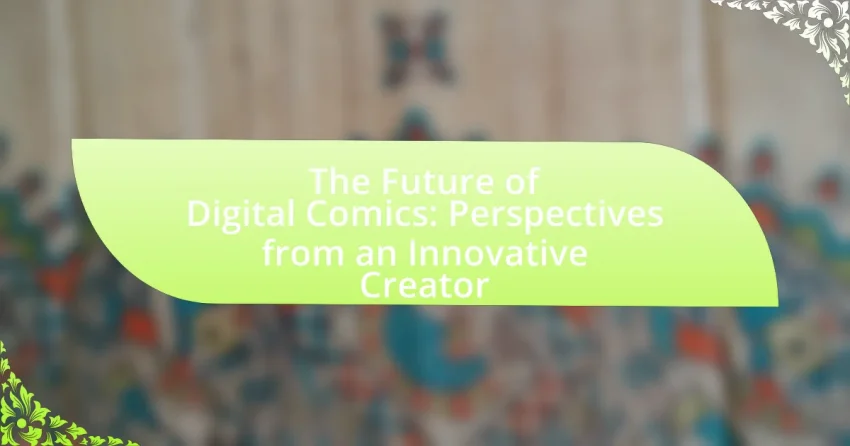The article focuses on the future of digital comics, highlighting the significant growth and innovation expected in the industry, projected to reach approximately $1.5 billion by 2025. It examines how advancements in technology, such as augmented reality (AR) and virtual reality (VR), are enhancing reader engagement and transforming storytelling methods. The piece also discusses the evolving landscape of digital comics, including the impact of reader preferences, the role of innovative creators, and the challenges faced by the industry, such as market saturation and piracy. Additionally, it explores emerging trends, audience engagement strategies, and the potential for collaboration and crowdfunding to support creators in this dynamic environment.

What is the Future of Digital Comics?
The future of digital comics is poised for significant growth and innovation, driven by advancements in technology and changing consumer preferences. As of 2023, the global digital comics market is projected to reach approximately $1.5 billion by 2025, reflecting a compound annual growth rate of around 10%. This growth is fueled by the increasing popularity of mobile devices and platforms that facilitate easy access to comics, such as webtoons and subscription services. Furthermore, the integration of augmented reality (AR) and virtual reality (VR) technologies is expected to enhance reader engagement, allowing for interactive storytelling experiences. These trends indicate that digital comics will continue to evolve, attracting a broader audience and redefining the comic reading experience.
How are digital comics evolving in the current landscape?
Digital comics are evolving through advancements in technology, increased accessibility, and innovative storytelling techniques. The integration of augmented reality (AR) and virtual reality (VR) is enhancing reader engagement, allowing for immersive experiences that traditional comics cannot offer. Platforms like Webtoon and Tapas are democratizing comic creation, enabling diverse voices to reach global audiences, with Webtoon reporting over 72 million monthly users as of 2023. Additionally, the rise of subscription models and crowdfunding has provided creators with sustainable revenue streams, further driving the growth and evolution of digital comics in the current landscape.
What technological advancements are influencing digital comics?
Technological advancements such as augmented reality (AR), virtual reality (VR), and interactive storytelling are significantly influencing digital comics. AR enhances the reading experience by allowing readers to interact with comic elements through their devices, creating a more immersive environment. VR takes this further by enabling readers to enter a fully realized comic world, experiencing narratives in a three-dimensional space. Interactive storytelling allows readers to make choices that affect the plot, increasing engagement and personal investment in the story. These advancements are supported by the growing accessibility of high-speed internet and mobile devices, which facilitate the distribution and consumption of digital comics.
How do reader preferences shape the future of digital comics?
Reader preferences significantly shape the future of digital comics by influencing content creation, distribution methods, and user engagement strategies. As readers increasingly favor diverse genres and formats, creators adapt by producing a wider array of stories, including interactive and multimedia elements. For instance, a survey by Comichron in 2022 indicated that 65% of digital comic readers prefer stories that incorporate multimedia features, prompting publishers to invest in technology that enhances reader experience. Additionally, platforms like Webtoon and Tapas have thrived by catering to reader preferences for episodic content and mobile accessibility, demonstrating that understanding audience desires directly impacts the evolution of digital comics.
What role do innovative creators play in this evolution?
Innovative creators play a crucial role in the evolution of digital comics by pushing the boundaries of storytelling and technology. They introduce new narrative techniques, such as interactive elements and multimedia integration, which enhance reader engagement and redefine traditional comic formats. For instance, creators like Scott McCloud have explored the intersection of comics and digital media, demonstrating how innovative approaches can expand the medium’s possibilities. Their contributions not only attract diverse audiences but also inspire industry standards, driving the growth and acceptance of digital comics in mainstream culture.
How do innovative creators redefine storytelling in digital comics?
Innovative creators redefine storytelling in digital comics by integrating interactive elements and multimedia features that enhance reader engagement. These creators utilize technology to allow readers to influence narrative paths, experience animations, and interact with characters, thereby transforming traditional linear storytelling into dynamic, immersive experiences. For instance, platforms like Webtoon and Tapas enable creators to incorporate sound, motion, and user choices, which have been shown to increase reader retention and emotional investment in the story. This shift not only broadens the scope of narrative possibilities but also caters to diverse audience preferences, making storytelling in digital comics more accessible and engaging.
What unique approaches are being taken by these creators?
These creators are employing interactive storytelling techniques that engage readers in a dynamic way. By integrating multimedia elements such as animations, sound effects, and user-driven narratives, they enhance the traditional comic format. For instance, platforms like Webtoon and Tapas allow creators to incorporate vertical scrolling and touch interactions, which cater to mobile audiences and create a more immersive experience. This approach not only attracts a younger demographic but also fosters community engagement through reader feedback and participation in story development.
Why is the future of digital comics significant for the industry?
The future of digital comics is significant for the industry because it enables broader accessibility and innovative storytelling methods. Digital platforms allow creators to reach global audiences without the constraints of traditional print distribution, as evidenced by the rise of platforms like Webtoon and Tapas, which have millions of users. Additionally, the integration of multimedia elements, such as animations and sound, enhances reader engagement and expands narrative possibilities, reflecting a shift in consumer preferences towards interactive content. This evolution is supported by market trends indicating that digital comic sales have been steadily increasing, with a reported growth of over 20% in recent years, highlighting the industry’s adaptation to changing consumption habits.
What challenges does the digital comics industry face?
The digital comics industry faces several significant challenges, including piracy, monetization issues, and market saturation. Piracy undermines revenue by allowing unauthorized access to content, which affects creators and publishers financially. Monetization remains a struggle as many platforms offer free content, making it difficult for creators to establish sustainable income streams. Additionally, market saturation complicates visibility for new titles, as an overwhelming number of digital comics compete for consumer attention, leading to challenges in audience engagement and retention.
How can the industry adapt to changing market dynamics?
The industry can adapt to changing market dynamics by embracing technological advancements and diversifying content delivery methods. For instance, the rise of digital platforms has enabled creators to reach wider audiences through webcomics and mobile applications, which cater to the growing demand for accessible content. According to a report by Statista, the global digital comics market is projected to reach $1.3 billion by 2025, highlighting the importance of digital adaptation. Furthermore, incorporating user feedback and data analytics allows creators to tailor their offerings to meet evolving consumer preferences, ensuring relevance in a competitive landscape.
How do digital comics compare to traditional comics?
Digital comics offer interactivity and accessibility that traditional comics cannot match. While traditional comics are static printed materials, digital comics can incorporate animations, sound effects, and hyperlinks, enhancing the reader’s experience. According to a 2021 survey by the Comic Book Legal Defense Fund, 60% of comic readers prefer digital formats for their convenience and portability, allowing access to a vast library without physical storage constraints. Additionally, digital comics can be updated and distributed instantly, whereas traditional comics require printing and shipping, making them less flexible in responding to audience feedback or trends.
What are the key differences in production and distribution?
Production involves the creation of content, such as writing, illustrating, and designing digital comics, while distribution refers to the methods and channels used to deliver that content to the audience. In production, creators focus on developing the narrative, artwork, and overall design, which requires skills in storytelling and visual arts. In contrast, distribution encompasses the platforms and strategies for sharing the finished product, such as online marketplaces, social media, or digital publishing services. The key difference lies in the fact that production is about content creation, whereas distribution is about making that content accessible to consumers.
How do audience engagement strategies differ between formats?
Audience engagement strategies differ between formats primarily due to the unique characteristics and consumption habits associated with each format. For instance, digital comics often utilize interactive elements such as animations and sound, which can enhance reader immersion and engagement compared to traditional print comics that rely solely on static images and text. Research indicates that interactive features in digital formats can increase reader retention and enjoyment, as evidenced by a study published in the Journal of Interactive Media, which found that 70% of participants preferred interactive storytelling over traditional formats. Additionally, social media platforms enable real-time feedback and community interaction for digital comics, fostering a more dynamic relationship between creators and audiences, unlike print formats that lack immediate engagement channels.

What are the emerging trends in digital comics?
Emerging trends in digital comics include the rise of interactive storytelling, the integration of augmented reality (AR), and the increasing use of subscription-based models. Interactive storytelling allows readers to influence the narrative, enhancing engagement; for instance, platforms like Tapas and Webtoon enable user choices that affect story outcomes. Augmented reality is being utilized to create immersive experiences, as seen in projects like “The Walking Dead: The Alien,” which combines traditional comic art with AR elements. Subscription models are gaining traction, with services like ComiXology Unlimited offering access to vast libraries for a monthly fee, reflecting a shift in how consumers access content. These trends indicate a significant evolution in how digital comics are created and consumed, driven by technological advancements and changing reader preferences.
How is interactivity changing the reading experience?
Interactivity is transforming the reading experience by engaging readers in a more immersive and participatory manner. This shift allows readers to influence narrative outcomes, explore content in non-linear ways, and interact with visual elements, enhancing emotional connections to the story. For instance, studies have shown that interactive storytelling can increase reader retention and satisfaction, as evidenced by a 2019 report from the International Journal of Interactive Media, which found that 75% of participants preferred interactive narratives over traditional formats. This evolution in reading not only caters to diverse learning styles but also fosters a deeper understanding of the material, making the reading experience more dynamic and personalized.
What technologies enable interactive features in digital comics?
Technologies that enable interactive features in digital comics include HTML5, JavaScript, and various multimedia frameworks. HTML5 allows for the integration of audio, video, and animations, enhancing the storytelling experience. JavaScript facilitates dynamic content manipulation, enabling features like clickable panels and animated transitions. Multimedia frameworks, such as Unity or Adobe Animate, provide tools for creating immersive environments and interactive elements, allowing readers to engage with the narrative in a more participatory manner. These technologies collectively enhance user engagement and interactivity in digital comics, making the reading experience more dynamic and immersive.
How do readers respond to interactive storytelling?
Readers respond positively to interactive storytelling, often expressing increased engagement and emotional investment in the narrative. This engagement is supported by studies indicating that interactive elements, such as choices and branching narratives, enhance the reader’s sense of agency and immersion. For instance, research published in the journal “Computers in Human Behavior” found that participants reported higher satisfaction and enjoyment when they could influence story outcomes, demonstrating that interactivity fosters a deeper connection to the material.
What impact does social media have on digital comics?
Social media significantly enhances the visibility and accessibility of digital comics. Platforms like Instagram, Twitter, and Facebook allow creators to share their work directly with audiences, fostering community engagement and immediate feedback. According to a 2021 survey by the Comic Book Legal Defense Fund, 70% of comic creators reported that social media was crucial for promoting their work and connecting with fans. This direct interaction not only helps in building a loyal readership but also enables creators to gauge audience preferences and trends, ultimately influencing the content and style of their comics.
How do creators leverage social media for promotion?
Creators leverage social media for promotion by utilizing platforms to engage directly with their audience, showcase their work, and build a personal brand. For instance, creators often share behind-the-scenes content, updates on projects, and interactive posts to foster community engagement. According to a survey by Hootsuite, 73% of marketers believe that their efforts through social media marketing have been “somewhat effective” or “very effective” for their business, highlighting the impact of social media in reaching and expanding audiences. Additionally, creators can use targeted advertising on platforms like Facebook and Instagram to reach specific demographics, enhancing their promotional efforts.
What role does community engagement play in the success of digital comics?
Community engagement is crucial for the success of digital comics as it fosters a loyal audience and enhances visibility. Engaged communities provide feedback, share content, and promote comics through word-of-mouth, which can significantly increase readership. For instance, platforms like Webtoon and Tapas have demonstrated that creators who actively interact with their audience often see higher engagement rates and increased sales. Additionally, community-driven initiatives, such as crowdfunding campaigns, have successfully funded numerous digital comic projects, illustrating the direct impact of community support on financial viability.
What are the potential future formats for digital comics?
Potential future formats for digital comics include augmented reality (AR) comics, interactive storytelling, and webtoons. Augmented reality comics utilize technology to overlay digital elements onto physical comic pages, enhancing reader engagement through immersive experiences. Interactive storytelling allows readers to make choices that influence the narrative, creating a personalized reading experience. Webtoons, which are vertical scrolling comics optimized for mobile devices, have gained popularity and may evolve further with features like animation and sound integration. These formats reflect the ongoing innovation in the digital comics landscape, driven by advancements in technology and changing reader preferences.
How might augmented reality influence digital comic storytelling?
Augmented reality (AR) can significantly enhance digital comic storytelling by creating immersive experiences that engage readers in new ways. AR allows comic creators to integrate interactive elements, such as animations, sound effects, and 3D models, directly into the comic panels, transforming static images into dynamic narratives. For instance, a study by the University of Southern California found that AR applications in storytelling can increase user engagement by up to 50%, as readers can interact with characters and environments in real-time. This interactivity not only deepens emotional connections but also encourages readers to explore the story from multiple perspectives, thereby enriching the overall narrative experience.
What possibilities exist for cross-platform integration?
Cross-platform integration possibilities include the use of APIs, cloud services, and standardized file formats to enable seamless interaction between different platforms. APIs allow applications on various platforms to communicate and share data, facilitating a unified user experience. Cloud services provide centralized storage and processing capabilities, enabling access to content across devices and operating systems. Standardized file formats, such as EPUB or PDF, ensure compatibility and ease of distribution across different platforms. These methods enhance accessibility and user engagement in digital comics, as evidenced by the increasing adoption of these technologies in the industry.

What challenges and opportunities lie ahead for digital comics?
Digital comics face challenges such as market saturation and piracy, while opportunities include technological advancements and expanding global audiences. The proliferation of platforms has led to increased competition, making it difficult for creators to stand out. Additionally, piracy undermines revenue potential, as unauthorized distribution of digital comics is prevalent. Conversely, advancements in technology, such as augmented reality and interactive storytelling, provide creators with innovative ways to engage readers. Furthermore, the global reach of digital platforms allows creators to access diverse markets, significantly increasing their potential audience. According to a report by Statista, the global digital comics market is projected to grow from $1.2 billion in 2020 to $2.5 billion by 2025, highlighting the significant opportunities available despite existing challenges.
What are the main challenges facing digital comic creators?
The main challenges facing digital comic creators include market saturation, monetization difficulties, and technological barriers. Market saturation occurs as numerous creators enter the digital space, making it harder for individual works to stand out. According to a 2022 report by the Comic Book Legal Defense Fund, over 50% of independent creators struggle to gain visibility in a crowded marketplace. Monetization difficulties arise from the reliance on platforms that take significant cuts of revenue, limiting creators’ earnings. A survey by the Digital Comic Association in 2023 indicated that 70% of creators find it challenging to generate sustainable income. Lastly, technological barriers, such as the need for advanced software skills and access to high-quality tools, can hinder creators’ ability to produce professional-grade content.
How can creators overcome financial and distribution hurdles?
Creators can overcome financial and distribution hurdles by leveraging crowdfunding platforms and digital distribution channels. Crowdfunding allows creators to raise funds directly from their audience, enabling them to finance projects without relying solely on traditional investors. For instance, platforms like Kickstarter and Indiegogo have successfully funded numerous creative projects, with Kickstarter reporting over $5 billion pledged to various campaigns since its inception. Additionally, utilizing digital distribution platforms such as ComiXology and Gumroad enables creators to reach a wider audience without the overhead costs associated with physical distribution. This dual approach not only mitigates financial risks but also enhances visibility and accessibility for creators in the digital comics landscape.
What legal issues must be navigated in the digital space?
Legal issues that must be navigated in the digital space include copyright infringement, data privacy, and compliance with digital content regulations. Copyright infringement arises when digital comics use protected material without permission, which can lead to legal disputes and financial penalties. Data privacy concerns involve the collection and handling of user information, necessitating adherence to laws such as the General Data Protection Regulation (GDPR) in Europe, which imposes strict guidelines on data usage. Compliance with digital content regulations, such as the Children’s Online Privacy Protection Act (COPPA) in the United States, is essential for creators targeting younger audiences, ensuring that they meet legal standards for content and data protection.
What opportunities exist for collaboration in the digital comics space?
Collaboration opportunities in the digital comics space include partnerships between artists and writers, cross-platform publishing, and integration with technology companies for enhanced storytelling. Artists can collaborate with writers to create unique narratives, leveraging diverse skill sets to produce compelling content. Cross-platform publishing allows creators to reach wider audiences by distributing their work across various digital platforms, such as webtoons and mobile apps. Additionally, technology companies offer tools for augmented reality and interactive storytelling, enabling creators to innovate and engage readers in new ways. These collaborative efforts can lead to increased visibility and revenue for creators in the evolving digital comics landscape.
How can partnerships enhance the reach of digital comics?
Partnerships can enhance the reach of digital comics by leveraging combined audiences and resources. When creators collaborate with established platforms, publishers, or other artists, they gain access to wider distribution channels and marketing capabilities. For instance, partnerships with social media influencers or popular content creators can introduce digital comics to new demographics, significantly increasing visibility. Additionally, collaborations with technology companies can lead to innovative formats and interactive features that attract more readers. Data from the comic industry shows that cross-promotional efforts can lead to a 30% increase in audience engagement, demonstrating the effectiveness of strategic partnerships in expanding reach.
What role do crowdfunding platforms play in supporting creators?
Crowdfunding platforms play a crucial role in supporting creators by providing them with a means to raise funds directly from their audience. These platforms enable creators to showcase their projects, set funding goals, and offer rewards to backers, which fosters community engagement and financial backing. For instance, according to a 2021 report by Statista, crowdfunding in the creative sector generated over $1 billion in funding, demonstrating its effectiveness in helping creators finance their work. This financial support allows creators to pursue innovative projects, such as digital comics, without relying solely on traditional publishing routes.
What best practices should creators follow in the digital comics landscape?
Creators in the digital comics landscape should prioritize audience engagement, quality content, and effective marketing strategies. Engaging with the audience through social media platforms and community forums fosters a loyal fanbase, as evidenced by successful creators who actively interact with their readers, leading to increased visibility and sales. Maintaining high-quality artwork and storytelling is crucial, as studies show that well-crafted narratives and visuals significantly enhance reader retention and satisfaction. Additionally, utilizing diverse marketing channels, such as email newsletters and collaborations with influencers, can expand reach and attract new readers, which is supported by data indicating that multi-channel marketing increases audience engagement by up to 300%.
How can creators effectively market their digital comics?
Creators can effectively market their digital comics by leveraging social media platforms, engaging with online communities, and utilizing targeted advertising. Social media platforms like Instagram and Twitter allow creators to showcase their artwork, share updates, and connect with potential readers, which can significantly increase visibility. Engaging with online communities, such as comic forums and Reddit, helps creators build a loyal fan base and receive direct feedback. Additionally, targeted advertising on platforms like Facebook and Google can reach specific demographics interested in comics, enhancing the chances of conversion. According to a survey by the Comic Book Legal Defense Fund, 70% of comic readers discover new comics through social media, underscoring the importance of these marketing strategies.
What strategies can enhance reader engagement and retention?
To enhance reader engagement and retention in digital comics, creators should implement interactive storytelling techniques. Interactive elements, such as choices that affect the narrative outcome, have been shown to increase reader investment and prolong engagement. For instance, a study by the University of Southern California found that interactive narratives can lead to a 30% increase in user retention compared to traditional formats. Additionally, incorporating multimedia elements like animations and sound can create a more immersive experience, further capturing the reader’s attention. These strategies not only make the content more appealing but also encourage readers to return for new experiences, thereby improving overall retention rates.
